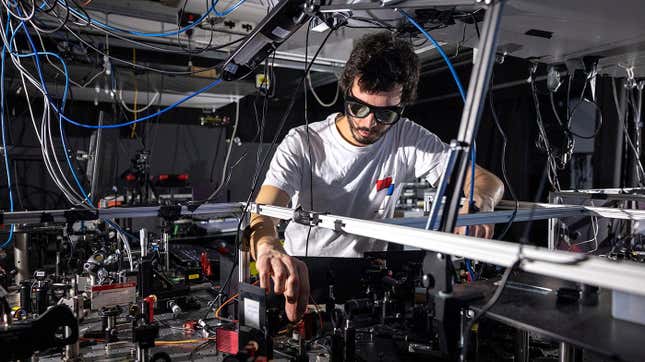
A team of physicists has recreated a classic experiment in particle physics with a dimensional twist, by performing it in time instead of just space. In the process, they showcased the utility of a unique material for future experiments.
The researchers redesigned the double-slit experiment, which was first performed in 1801 and demonstrated a curious trait of light: that it can behave both as a particle and a wave.
The original experiment tested how light moved through space; the recent rendition tested how light would travel if it was only allowed to at specific times. Details of the team’s work are published today in Nature Physics.
“Our experiment reveals more about the fundamental nature of light while serving as a stepping-stone to creating the ultimate materials that can minutely control light in both space and time,” said Riccardo Sapienza, a physicist at Imperial College London and the study’s lead author, in a university release.
In the traditional experiment, a beam of light is projected at a barrier, behind which is a photosensitive detector. The barrier has two parallel slits. If you threw ordinary matter at the barrier, they would roughly form the same shape as the slits on the detector. But when light is cast on the slits, it splits into two waves that pass through the barrier and intersect on the other side. Though there are just two slits for the light to pass through, the photosensitive material shows more than two bars of light.
When the light waves intersect, they recombine and cancel each other out, creating a banded pattern on the photosensitive material. The experiment was a watershed moment in understanding the behavior of small particles, and it paved the way for similar experiments with electrons and even antimatter and the field of quantum mechanics as a whole (which was nonexistent in 1801).
In the new work, the researchers made one big change: They swapped out an ordinary screen with two slits for an indium-tin-oxide film—the same material that is used in modern phone screens. (It’s actually a metamaterial, or a material not found in nature, that is engineered to behave a certain way.)
The researchers changed the reflectance of the screen using ultrafast lasers, which only allowed light through at specific times, quadrillionths of a second apart. Basically, they built a quantum tollbooth, using the lasers to create time-dependent slits in the barrier. Even when they only allowed one photon through the screen, the light produced an interference pattern.
Indium-tin-oxide is engineered to respond quickly to light, making it ideal for testing light’s behavior on ultrafast timescales. Laser pulses are also used to improve the endurance of quantum bits, or qubits, using similar principles of probing the behavior of quantum particles in time.
Next, the research team hopes to turn its attention the behavior of time crystals, or crystals whose structures change across instances of time.
More: Physicists Got a Quantum Computer to Work by Blasting It With the Fibonacci Sequence